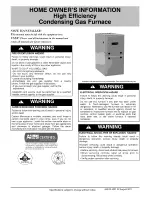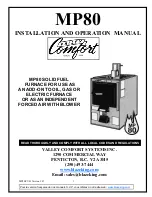
4
• When installed in a residential garage, the furnace
must be positioned so the burners and ignition source
are located not less than 18 inches (457 mm) above the
floor and protected from physical damage by vehicles.
II. General Information
WARNING
Possible death, personal injury or property
damage due to fire, explosion, smoke, soot,
condensation, electrical shock or carbon
monoxide may result from improper
installation, repair, operation, or
maintenance on this product.
To ensure the furnace operates safely and efficiently, it
must be installed, operated and maintained in accordance
with these installation and operating instructions, all local
building codes and ordinances, or, in their absence, with
the latest edition of the National Fuel Gas Code, ANSI
Z223.1*, and/or CAN/CGA B149 Installation Codes.
The rated heating capacity of the furnace should be greater
than or equal to the total heat loss of the area to be heated.
The total heat loss should be calculated by an approved
method or in accordance with “ASHRAE. Guide” or “Manual
J-Load Calculations” published by the Air Conditioning
Contractors of America.
*Obtain from: American National Standards Institute 1430
Broadway New York, NY 10018
TRANSPORTATION DAMAGE
Check the furnace for any shipping damage. If damage is
found, contact the company where the furnace was pur-
chased.
While checking for transportation damage, remove all pack-
aging material and dispose or recycle according to local
codes.
THERMOSTAT LOCATION
Locate the thermostat about 5 feet high on a vibration-free
inside wall, in an area having good air circulation
Do not install the thermostat where it may be affected by:
• drafts or dead spots behind door, in corners or under
cabinets.
• hot or cold air from ducts.
• radiant heat from sun or appliances.
• concealed pipes and chimneys.
• unheated (uncooled) areas behind the thermostat,
such as an outside wall.
Consult the instructions packaged with the thermostat for
mounting instructions.
III. Air Requirements
COMBUSTION AND VENTILATION AIR
WARNING
Possible death, personal injury or property
damage may occur if the furnace and other
fuel-burning appliances are not provided
with enough fresh air for proper combustion
and ventilation of flue gases. Most homes
require outside air to be supplied into the
furnace area.
Improved construction and additional insulation in build-
ings has reduced the heat loss, making these buildings
much tighter around doors and windows so air infiltration is
minimal. This creates a problem supplying combustion and
ventilation air for gas fired and other fuel burning appli-
ances. Use of appliances pulling air out of the house
(clothes dryers, exhaust fans, fireplaces, etc.) increases
this problem causing appliances to starve for air.
This furnace must use indoor air for combustion. It cannot
be installed as a direct vent (i.e., sealed combustion)
furnace. The burner box is present only to help reduce
sound transmission from the burners to the occupied space.
AIR REQUIREMENTS
Most homes will require outside air supplied to the furnace
area by means of ventilation grilles or ducts connecting
directly to the outdoors or spaces open to the outdoors such
as attics or crawl spaces. The following information on air
for combustion and ventilation is reproduced from the
National Fuel Gas Code NFPA54/ANSI Z223.1 Section
5.3.
5.3.1 General:
(a) The provisions of 5.3 apply to gas utilization equipment
installed in buildings and which require air for combustion,
ventilation and dilution of flue gases from within the build-
ing. They do not apply to (1) direct vent equipment which is
constructed and installed so that all air combustion is
obtained from the outside atmosphere and all flue gases
are discharged to the outside atmosphere, or (2) enclosed
furnaces which incorporate an integral total enclosure and
use only outside air for combustion and dilution of flue
gases.
(b) Equipment shall be installed in a location in which the
facilities for ventilation permit satisfactory combustion of
gas, proper venting and the maintenance of ambient tem-
perature at safe limits under normal conditions of use.
Equipment shall be located so as not to interfere with proper
circulation of air. When normal infiltration does not provide
the necessary air, outside air shall be introduced.





































